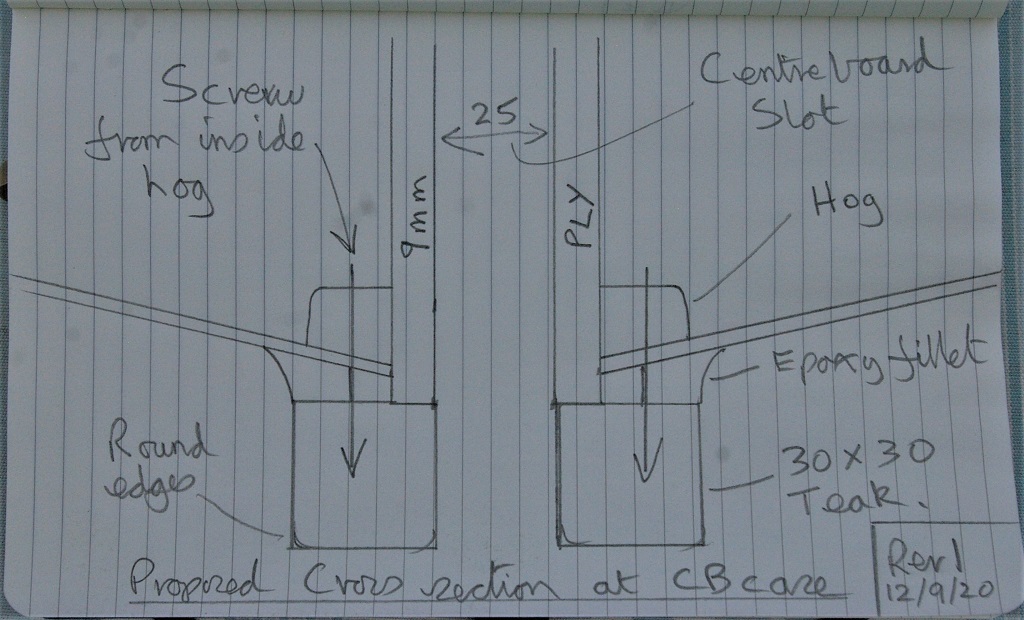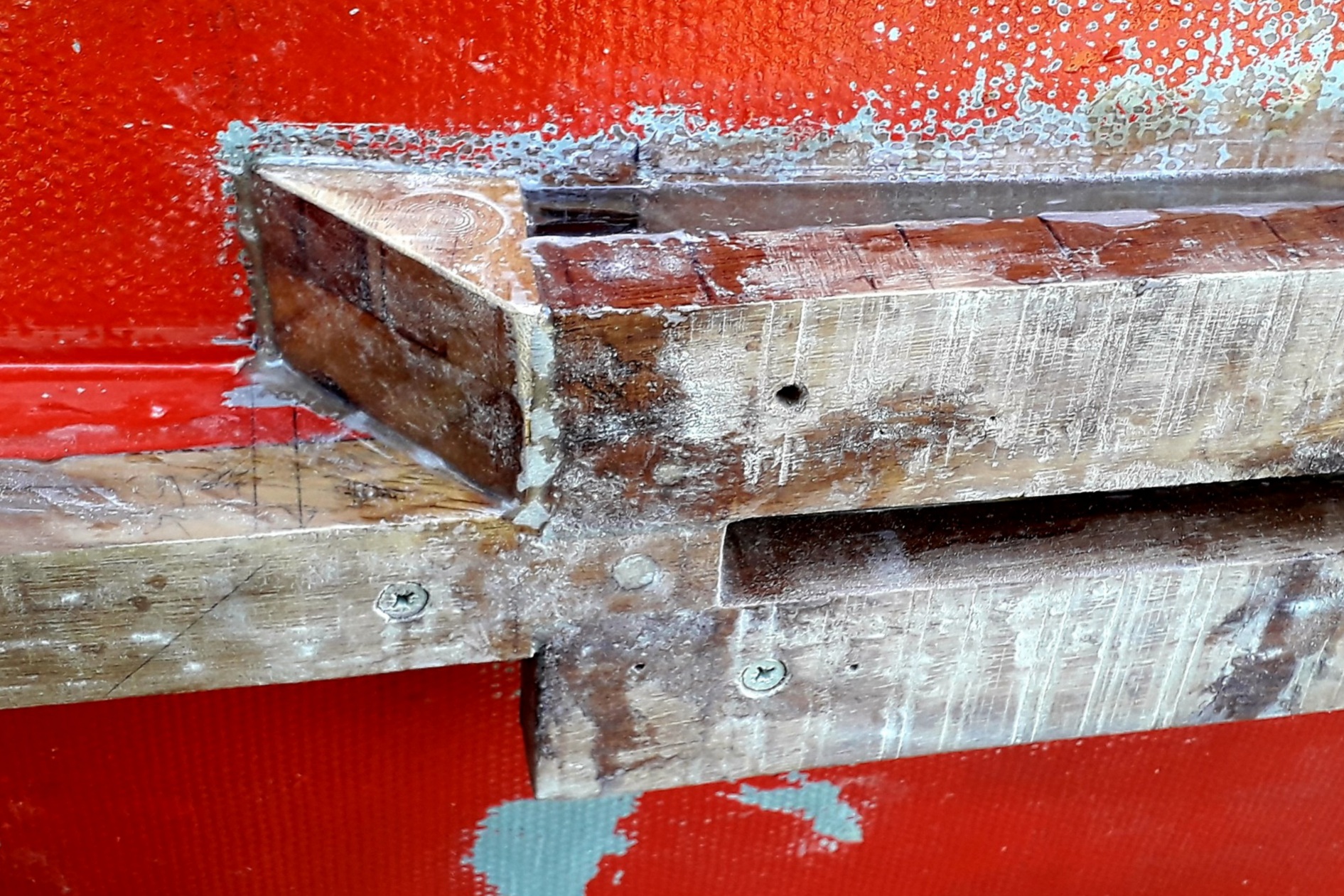New Keel
|
|
MilliBee needs a new keel, stronger and wider than before.
The Starboard Oak trim on the centreboard case broke away at Cobnor, long story. When I chiselled the remains of it off I discovered the case plywood (9mm) was slightly damp. I scraped out as much as possible (maybe 20mm deep), dried it with a heat gun, treated it with Ronseal Wet Rot Restorer, sanded it, primed with thin epoxy then filled with thickened epoxy. Sealing the ply is mission critical, because rebuilding the case would be a mountain of work. Then I'll look at gluing a new keel and screwing it into the strong hog with stainless screws. I have a selection of wood: many Oak kitchen door frames, strips of Oak, ten Teak blocks that I rescued from the neighbours wood stove pile (the blocks are a school window frame chopped up!), four Teak lengths that I bought from Robbins at Beale for £15 each, plenty of what Richard called Red Mahogany.  I would appreciate advice on the best wood to use for the keel, how to fix it and how to seal it. Teak seems logical, I have enough to replace the Oak trim on the skeg and make the entire keel from Teak. But I have no experience of using Teak. Paul Fisher's plans included Iroko runners which I never fitted. But long hardwood runners would strengthen the 6mm ply hull which over the years has twice splintered internally. Perhaps Red Mahogany would be ok for runners? Cheers Paul |
|
|
The plan is larger 30x30mm Teak capping each side. With the 25mm slot gap the total of 85mm will just fit inside a flat keel roller, which is typically flat for 88mm.
 Assuming I clean the Teak with a solvent before gluing, does this make sense? -Paul PS: Previous Oak was 20mm high x 18mm wide but with a large radius edge - that small footprint of about 12mm cut into the roller which failed to roll. Spreading weight over 30mm will be much better. PPS: The Teak planks are about 1 5/8th in or 41mm thick. So I could make the cappings 41 high x 30 wide. That avoids a 2nd cut and keeps the bottom panels further from rocks when dried out. With wider rollers 41 x 41 could be used, which would be proportioned more like a traditional wooden keel boat. |
|
|
The epoxy fillet looks expensive, can you make that mostly from wood? Do a test with and without wiping acetone on your teak before gluing; I did that test and not wiping gave a stronger joint! - but the rest of the world says otherwise. You may have to laminate your wood from two layers to more easily follow the rocker of Millibee's bottom.
|
|
|
In Safari I can't sign in to HBBR but I can choose photos for most forums. In Chrome I can't post photos, and I can't edit my previous post! So you have to imagine the photo of my keel and bilge runners; keel in one piece as almost completely flat, bilge runners laminated from two pieces, both have plastic rubbing strips 10mm thick and I would happily drag the boat over concrete.
|
|
|
I've had problems in Safari, too, it seems that this forum is now locked down, and cannot be viewed unless logged in, and for some reason that seems to be an issue with Safari (typing this with Firefox on a Macbook Air). Not sure when the forum was locked down so it was no longer visible to anyone not logged in, as I'm sure it hasn't always been locked down like this. I guess it does mean that things here are private now, as no one that hasn't already joined can do so now, I guess.
|
|
|
In reply to this post by Alan
Alan,
There is already a fillet of ply/epoxy next to the 9mm ply case (18mm total). My mistake for not labeling it. For the front half of the case only a few mm of epoxy will be needed. So the volume of epoxy is not a problem. From skeg to front of the case is flat, but yes two laminations will be needed from the case forwards. A 10mm plastic rubbing strip sounds interesting. Is it nylon and where did you source it? Al likes to use copper pipe hammered flat as a tough rubbing strip. The Red Mahogany I have is pre-curved, reclaimed from an old Heron frame. Thanks to the building gods it is 30mm wide already. I don't know how Red Mahogany and Teak compare for hardness and gluability. Perhaps Richard can advise. The Oak on the skeg looks rough, stripped of paint and epoxy on the bottom. Ditto for the case trim that didn't break off. Regarding photos, they must be below 1MB. Chrome works fine for me on all devices. Cheers Paul |
|
|
In reply to this post by Jeremy
Jeremy,
I have just checked the permissions and they are still set so that anyone can view the HBBR forum, as was the case years ago. Perhaps the Nabble owners have recently made changes in the background - it would not be the first time according to Greg. There might be a new glitch in how the permissions are inherited by sub-forums. I'll take a fresh look in the morning. Cheers Paul |
|
|
In reply to this post by Paul H (admin)
Those nice guys at Robbins Timber, a quick dash down the M5 from me, have sold me 25mm x 95mm x 4.5m sawn Iroko for the bargain price £27 total, which I can pickup tomorrow.
They won't have to saw it or organise delivery, which saves a lot of hassle and labour. Win Win. The machining guy said they have to sharpen blades every few minutes cutting Teak, Iroko is easier to cut and considered a poor man's Teak. Mike Wooldridge suggested Iroko at Cobnor, Paul Fisher's original Lynx 14 design specified Iroko. I just need to find some strong stainless screws, half plain and half threaded. The fully threaded stainless screws can snap at the head, in my experience. -Paul |
|
|
My plastic rubbing strips are polyethylene (HDPE) 8mm thick, not 10, about 17mm wide. I just happen to have two spare pieces 1000mm long drilled and counterbored for screws, and a spare bit 1000mm x 44mm. I can "Hermes" them to you FOC if you want to try them out.
A bit of thread drift here; I've had a rotten chronic cough this year and now only sand teak etc. while wearing an industrial mask. Searching for a cause of the cough has revealed that teak, oak and iroko are all sensitisers liable to make an allergic reaction worse. Especially teak. |
|
|
Time for an update. November weather stopped progress, so I rolled her flat.
This year I discovered some rotting timbers supporting seating, so spent a lot of time lifting seats then tedious rebuilding. Lots of paint scraping to get a good epoxy bond. Now she is on her side again and I'm tidying up the fiddly bits. Here is the plan for fairing the Iroko at the end of the CB case:  Stainless strip will run along the Iroko then bend towards the hull. That should stop the stainless being torn off and streamline waterflow - I'll do similar at the other end. Backfill was not too bad and its very strong under compression. Alan your advice is timely. I've had a weird cough/cold recently and it may well be due Iroko dust. I normally use a dust extractor, may have forgotten to turn it on for a small cut. Yesterday started wearing my FFP3 mask bought for Covid, whilst using chop saw and band saw on Iroko. Will definitely use both mask and extractor from now on. The wood flour mix may have caused a reaction - it has a light dust that floats around. All hardwoods produce a very fine dust. We should be careful. Cheers Paul |
«
Return to Builds in Progress
|
1 view|%1 views
| Free forum by Nabble | Edit this page |

